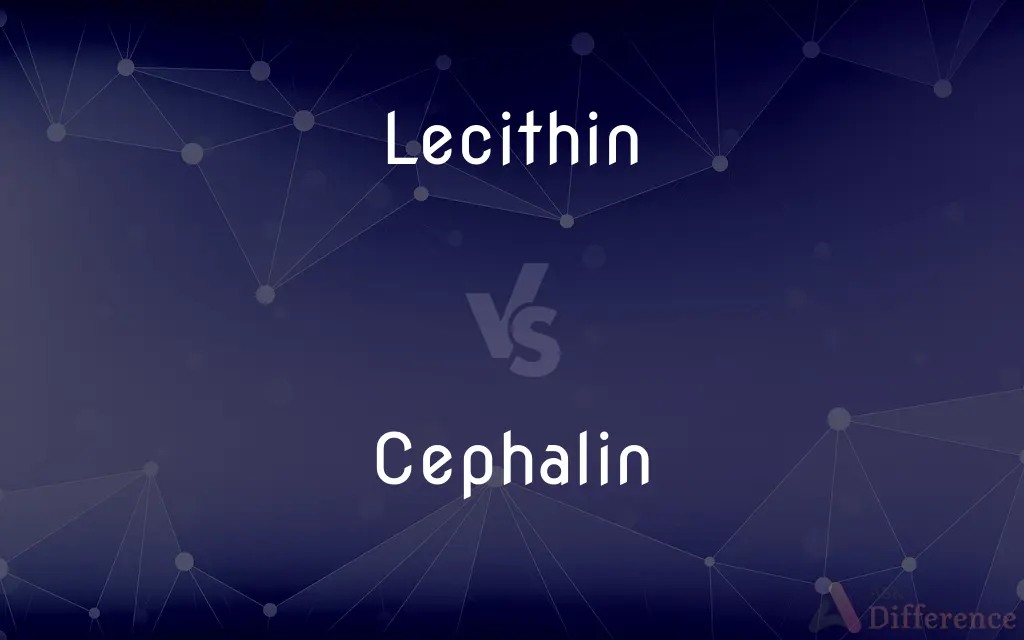Lecithin vs. Cephalin — What's the Difference?
By Maham Liaqat & Fiza Rafique — Updated on April 1, 2024
Lecithin and cephalin are both phospholipids crucial to cellular structure and function, but lecithin contains choline as a head group, while cephalin features ethanolamine or serine, affecting their roles and locations in biological membranes.

Difference Between Lecithin and Cephalin
Table of Contents
ADVERTISEMENT
Key Differences
Lecithin, also known as phosphatidylcholine, is a major component of cell membranes, known for its role in lipid transport and metabolism within the body. It is widely used in food and pharmaceutical industries as an emulsifier. Cephalin, or phosphatidylethanolamine and phosphatidylserine, plays key roles in cell signaling and membrane fusion processes. It is more abundantly found in the inner leaflet of the plasma membrane, influencing membrane curvature and cellular processes such as apoptosis.
While both lecithin and cephalin are essential for the structural integrity of cellular membranes, their functional differences are significant. Lecithin's choline head group makes it an effective emulsifier, which is why it's commonly used in manufacturing processes to blend ingredients that typically do not mix well. On the other hand, cephalin's presence is crucial in the brain and nervous system, contributing to the development and function of these critical areas.
Lecithin is often extracted from soybeans, eggs, and sunflower seeds for commercial use, making it a common ingredient in food products, cosmetics, and medications. Cephalin, while not as widely used in commercial products, is vital in medical and scientific research, particularly in studies related to nerve function and brain health.
The metabolism of lecithin in the body involves its breakdown into choline, which is important for liver function, muscle movement, and brain development. Cephalin, with its different head groups, participates in pathways that are critical for cell life and death decisions, showcasing the diversity of phospholipids in biological systems.
The extraction and commercial application of these phospholipids highlight their economic importance, with lecithin being more prominently featured in consumer products due to its emulsifying properties. However, both play indispensable roles in maintaining cellular structure and function, demonstrating the complexity and specialization of biological molecules.
ADVERTISEMENT
Comparison Chart
Head Group
Choline
Ethanolamine or Serine
Role in Membranes
Major component, involved in lipid transport
Important for cell signaling and membrane fusion
Commercial Uses
Emulsifier in foods, cosmetics, medications
Limited commercial use, important in research
Location in Cells
Throughout cellular membranes
Predominantly in the inner leaflet of plasma membranes
Biological Importance
Vital for liver function, muscle movement, brain development
Critical for nerve function, brain health, apoptosis
Compare with Definitions
Lecithin
Used commercially in food and pharmaceuticals.
The lecithin in ice cream helps to blend the water and fats for a smooth texture.
Cephalin
A phospholipid featuring ethanolamine or serine, involved in cell signaling.
Cephalin plays a key role in the fusion of biological membranes.
Lecithin
A phospholipid component of cell membranes with choline as a head group.
Lecithin is used as an emulsifier in chocolate to prevent the cocoa and cocoa butter from separating.
Cephalin
Found mainly in the brain and nervous system.
High concentrations of cephalin are essential for proper nerve function.
Lecithin
Important for metabolism and liver function.
Dietary lecithin contributes to choline intake, essential for metabolism.
Cephalin
Influences membrane curvature and cellular processes.
Cephalin contributes to the dynamic nature of cell membranes, affecting their shape and function.
Lecithin
Extracted from soybeans, eggs, and sunflower seeds.
Soy lecithin is a common food additive for its emulsifying properties.
Cephalin
Critical for apoptosis and cell health.
Cephalin components are involved in signaling pathways that trigger apoptosis.
Lecithin
Promotes brain development and function.
Choline from lecithin is crucial for brain health and development.
Cephalin
Less common in commercial products, vital in research.
Research on cephalin helps understand its role in neurological diseases.
Lecithin
Lecithin (, from the Greek lekithos "yolk") is a generic term to designate any group of yellow-brownish fatty substances occurring in animal and plant tissues which are amphiphilic – they attract both water and fatty substances (and so are both hydrophilic and lipophilic), and are used for smoothing food textures, emulsifying, homogenizing liquid mixtures, and repelling sticking materials.Lecithins are mixtures of glycerophospholipids including phosphatidylcholine, phosphatidylethanolamine, phosphatidylinositol, phosphatidylserine, and phosphatidic acid.Lecithin was first isolated in 1845 by the French chemist and pharmacist Théodore Gobley. In 1850, he named the phosphatidylcholine lécithine.
Cephalin
It is a example of glycerophospholipid. (Compound lipid).
Lecithin
Any of various substances containing phosphatidylcholine and a variety of other phospholipids, extracted from soybeans, egg yolks, or other sources and used as emulsifiers in a wide range of commercial products, including foods, cosmetics, paints, and plastics.
Cephalin
Any of a group of phospholipids found especially in the white matter of the brain and spinal cord.
Lecithin
See phosphatidylcholine.
Cephalin
(biochemistry) A phospholipid found particularly in the cells of nervous tissue; it is also the primary phospholipid in bacteria.
Lecithin
(organic chemistry) The principal phospholipid in animals; it is particularly abundant in egg yolks, and is extracted commercially from soy. It is a major constituent of cell membranes, and is commonly used as a food additive (as an emulsifier).
Cephalin
One of a group of phospholipids (nitrogenous phosphorized fatty substances), present in all living cells and particularly evident in nervous tissue. The cephalins consist of glycerol phosphate in which the two free hydroxyls of the glycerol are esterified with fatty acids, and the phosphate forms an ester linkage to the hydroxyl of ethanolamine. The phosphate may be linked to the alpha (end) or beta (middle) hydroxyl of the glycerol portion. The natural isomers are of the alpha form, and have the general formula R.O.CH2.CHOR´.CH2.O.PO2.O.CH2.CH2.NH2, where R and R´ are the acyl residues of long-chain fatty acids, which may be the same or different.
Lecithin
A yellow phospholipid essential for the metabolism of fats; found in egg yolk and in many plant and animal cells; used commercially as an emulsifier
Common Curiosities
Can consuming lecithin affect brain health?
Yes, lecithin's breakdown into choline is important for brain development and function.
Why is lecithin used as an emulsifier?
Its molecular structure allows it to bind both water and fats, making it effective in blending ingredients.
What distinguishes lecithin from cephalin?
The key difference is their head groups: lecithin contains choline, while cephalin features ethanolamine or serine.
Where is cephalin primarily found?
It is abundantly present in the brain and nervous system, playing roles in nerve function and signaling.
What is the significance of cephalin in cell membranes?
Cephalin is crucial for cell signaling, membrane fusion, and influencing membrane curvature, affecting various cellular processes.
Is cephalin used in food products like lecithin?
No, cephalin has limited commercial use compared to lecithin and is more focused on medical and scientific research.
How are lecithin and cephalin similar?
Both are phospholipids essential for the structural integrity of cell membranes and have roles in cellular function.
What are the commercial sources of lecithin?
Lecithin is commonly extracted from soybeans, eggs, and sunflower seeds for use in various products.
How does the body use lecithin?
It is metabolized into compounds like choline, which support liver function, muscle movement, and neurological development.
What role does cephalin play in apoptosis?
It is involved in signaling pathways that regulate cell death, crucial for removing damaged or unneeded cells.
Share Your Discovery

Previous Comparison
Symptom vs. Hallmark
Next Comparison
Plant vs. SpyAuthor Spotlight
Written by
Maham LiaqatCo-written by
Fiza RafiqueFiza Rafique is a skilled content writer at AskDifference.com, where she meticulously refines and enhances written pieces. Drawing from her vast editorial expertise, Fiza ensures clarity, accuracy, and precision in every article. Passionate about language, she continually seeks to elevate the quality of content for readers worldwide.















































